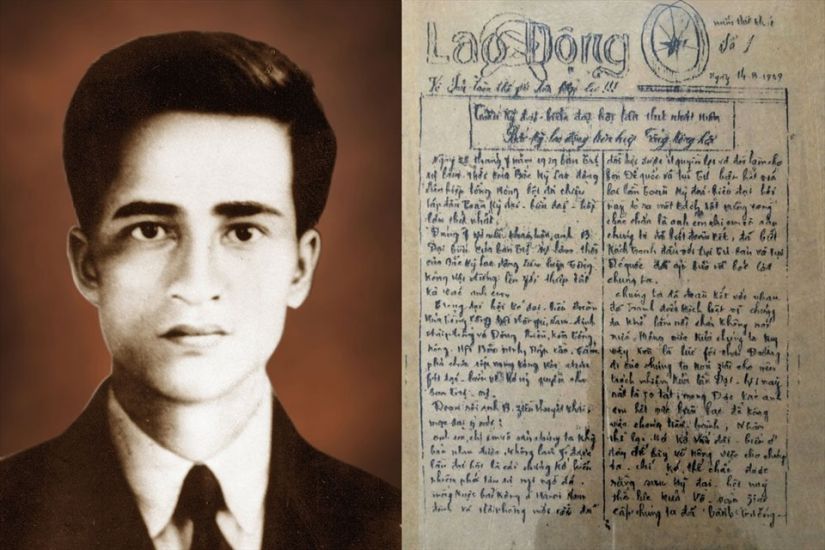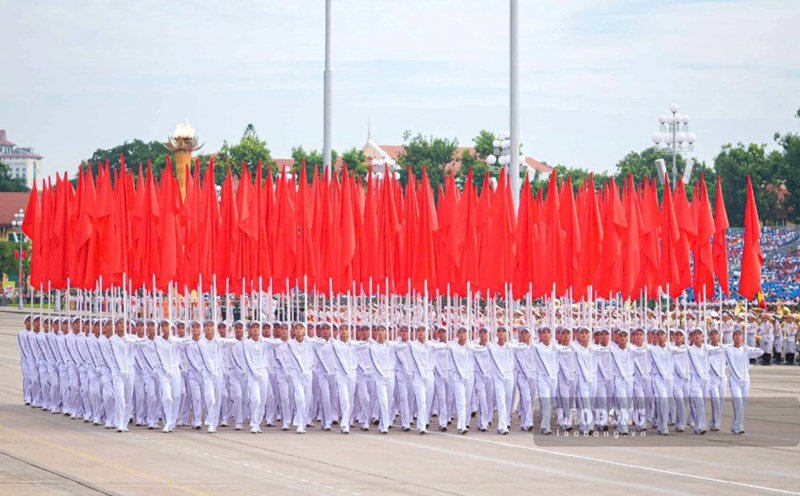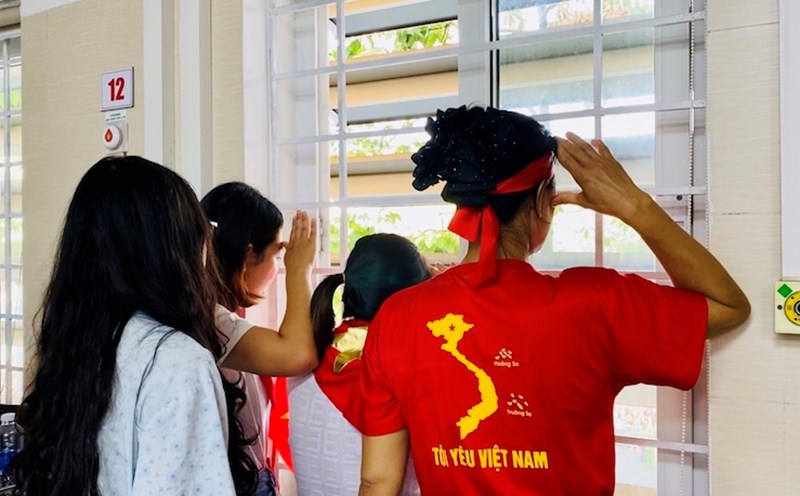From a royal house to a revolutionary facility
Before the Revolution, the house at 51 Hang Bo was owned by Mr. Pham Le Bong - a member of parliament, a rich person, influential in the political and economic world of the Northern region. This was originally a spacious and solid three-story building. The lower floor is used for printing machines and paper warehouses; the upper floor is used for compilation, arrangement of letters, and press molds.
In the days before the uprising, the office of the Editor of Binh Minh Newspaper (a private newspaper, existed from March 1945 to August 1945, published about 130 issues). Thanks to its characteristics as a printing facility, the house was quickly chosen by the revolutionary movement as a basis for activities when Hanoi was in a vibrant mood of the uprising.
51 Hang Bo - Historical days
On August 19, 1945, when Hanoi rose up to take power, house number 51 Hang Bo officially fell into the hands of the revolution. From a private press facility, this place immediately became the Headquarters of the Central Party Committee and the Central Committee of the Northern Redemption Workers' Union.
Here, comrade Tran Danh Tuyen and his colleagues urgently prepared for the release of Lao Dong Newspaper - the mouthpiece of the Workers' Union for National Rescue. The first people to contribute to that newspaper were musician Van Cao, journalist Tran Quoc Diep (Tran Luu Trac), Nguyen Huyen, and managers of Vu Tiep printing house.
In the history book of Lao Dong Newspaper, there is a statement from musician Van Cao - author of the National Anthem: "I have the honor that after the August Revolution, when Lao Dong Newspaper published its first public issue, I was present. Before that, I worked for Doc Lap newspaper. Having had a secret working relationship with Mr. Tran Danh Tuyen and Mr. Nguyen Huu Mai, when Mr. Tuyen was in charge of Lao Dong newspaper, I immediately left.
Every day I work directly with him at 51 Hang Bo, the headquarters of Lao Dong Newspaper. I write articles and stories while taking care of the pressing. Printing house on the first floor. After finishing the shift, I immediately went down to the workers' Association. And it was there all day, even all night.
The printing house lacks everything, the paper and ink are not available. The wording is confusing. We have to explore and find out what is still usable. How to make the printed newspaper beautiful. I was so surprised that I had to go back to get a new set of characters (a series of characters with legs) at my father-in-law's Rang Dong printing house later. With good words, you have to find a way to present it beautifully, clearly, brightly... Before me, I was a composer, wandering around the streets all day. Now, from morning to night, I am still hanging around the tables, the machines; the workers... still keeping the Morasse (ried printing revisions) still. It's hard but fun, don't know what fatigue is...
Lao Dong Newspaper is very beautiful, the letters have the most accurate letters at that time... Then, at the request of comrade To Huu, I was transferred to the Culture of National Rescue. I still stayed with Lao Dong Newspaper until the day the whole country fought".
Mounting difficulties: Lack of paper, lack of squid, lack of even synchronous machinery. But it was from the house at 51 Hang Bo that the first public issues of Lao Dong Newspaper were printed, spreading the revolutionary spirit to workers, laborers and people nationwide. On October 18, 1945, the first public issue of Lao Dong Newspaper was born, following the underground movement from previous secret publications.
Revolutionary base in the heart of the old town
On June 20, 4, at house number 51 Hang Bo, Hanoi, the National Trade Union Conference decided to change the name of the "National Workers' Union" to "Union"; unify trade union organizations nationwide and take the name of the Vietnam General Confederation of Labor.
In the two years 1945 - 1946, Lao Dong Newspaper from 51 Hang Bo published 30 issues, becoming an important forum reflecting the lives of workers, encouraging the spirit of "national salvation" in the early days of the young revolutionary government.
Many newspapers published President Ho Chi Minh's appeal, encouraging people to fight the hungry and the poor, and participate in the movement "hour to do the national saving". In particular, No. 21 issued on July 13, 1946 published the Charter of the Vietnam General Confederation of Labor - marking the establishment of a national trade union organization in this house.
Not only printing newspapers, the house at 51 Hang Bo was also once the headquarters of the secret agency of the Party and patriotic workers. According to the memories of many public service officers, the second floor of the house is a place where meetings are often held, where the safe is located to store important documents. This is also the place where the propaganda staff go back every day, both to work openly and to keep the secret of the pre-upgrade regime.
At 51 Hang Bo, many senior leaders of the Party directly directed the movement. General Secretary Truong Chinh once came here to work and instructed public employees to keep the principle of confidentiality. Musician Van Cao also described the time when he both composed and directly participated in the press printing work at this house.
At the end of 1946, at the risk of the French colonialists returning to invade, Hanoi prepared to enter a national resistance war. 51 Hang Bo becomes part of Inter-zone I - the center of resistance in the heart of the city. Many printers, equipment, and ink papers were secretly transferred from here to the battlefield. The last person to leave the headquarters was the manager of Vu Tiep printing house, carrying even the pencils, preparing for the "Three thousand days without rest" journey of the revolutionary press.
After the National Resistance War on December 19, 4, 4, right on the roof of this house, General Vo Nguyen Giap used a double-track tube to observe and command the battle to protect Hanoi. That shows that 51 Hang Bo is not only an address for the press and public transport, but also a military support in the early days of the long-term resistance war.
Today, the address 51 Hang Bo is still an inseparable part of Lao Dong Newspaper and the Trade Union organization. Although Hanoi has changed and Hang Bo street is busier, that house is still a symbol of historical memory and revolutionary fighting spirit.
For generations of Lao Dong journalists, 51 Hang Bo is a "second home", a place of gathering, unity, sharing, dedication and continuing the tradition of more than 96 years since leader Nguyen Duc Canh published the first issue of Lao Dong newspaper.
Revolutionary newspaper always serves the Fatherland
Together with the nation, along with the Trade Union organization, Lao Dong Newspaper has gone through history with important contributions from the beginning when the Revolution won power. Previously, on July 28, 1929, the first Congress of the Do Bac Ky General Confederation of Labor opened, chaired by comrade Nguyen Duc Canh. The Congress decided to establish the Bac Ky Red Cross Society, through the Charter and organization system of the Society, to issue the newspaper "Lao Dong" and the magazine "Red Society". On August 14, 1929, Lao Dong Newspaper published its first issue.
Over the past 96 years, Lao Dong Newspaper has contributed to the glorious revolutionary cause of the "Heroic nation, pioneering class". The history of Lao Dong Newspaper is an vivid and rich reflection of the history of the workers' movement and trade union activities in the process of the Vietnamese revolution under the leadership of the Party. Today, Lao Dong Newspaper has affirmed itself as one of the typical socio-political newspapers in the country.












